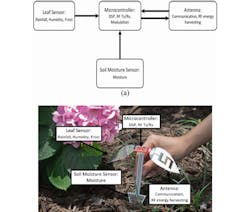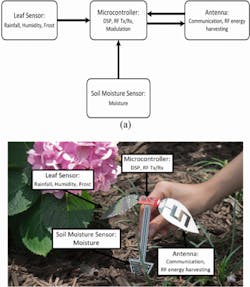Given the Internet of Things’ (IoT) need for low-power and wide environmental functionality in its technology, it may require design techniques like ambient power harvesting, ruggedness, and flexibility via conformal substrates. To gain greater understanding of batteryless IoT applications, A. Traille, A. Georgiadis, A. Collado, Y. Kawahara, H. Aubert, and M.M. Tentzeris have designed a scalable, low-cost, and ink-jet-printed wireless sensor platform. The team used several different 2D and 3D additive manufacturing techniques to test the eco-friendly operability of their devices.
To realize the microwave operation of inkjet-printed circuits on substrates, some commercial-off-the-shelf (COTS) components were used instead of organic thin-film transistors (OTFTs). Because OTFTs do not provide adequate performance when operating in the gigahertz range, discrete components fill the design gap. Using a paper base, the researchers investigate dual-battery/energy-harvesting techniques with the goal of increasing lifespan and wireless range. With a transmission frequency of 904.4 MHz, the paper-based circuit houses a microcontroller unit (MCU) that encodes analog sensor data into an amplitude-shift-keying (ASK) modulated signal.
To impedance-match the RFID circuitry with the antenna, an impedance of 60-j74 Ω is the conjugate matched to the half-wave dipole antenna. The antenna structure is printed using silver nanoparticles. Wireless-link measurements are performed using a Tektronix real-time spectrum analyzer, the 30408A, and a UHF RFID reader antenna. Extrapolating the reading of -48.1 dBm at 4.26 m, the researchers estimated that the link’s effective range would be between 142 to 175 m. See “Inkjet-printed ‘Zero-Power’ wireless sensor and power management nodes for IoT and ‘Smart Skin’ applications,” 2014 XXXIth URSI General Assembly and Scientific Symposium (URSI GASS), Aug 2014, p. 1-4.
About the Author
Jean-Jacques DeLisle
Jean-Jacques graduated from the Rochester Institute of Technology, where he completed his Master of Science in Electrical Engineering. In his studies, Jean-Jacques focused on Control Systems Design, Mixed-Signal IC Design, and RF Design. His research focus was in smart-sensor platform design for RF connector applications for the telecommunications industry. During his research, Jean-Jacques developed a passion for the field of RF/microwaves and expanded his knowledge by doing R&D for the telecommunications industry.

